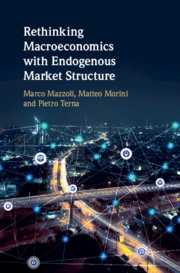Refine search
Actions for selected content:
35 results
Expectation formation and regime switches
-
- Journal:
- Experimental Economics / Volume 12 / Issue 3 / September 2009
- Published online by Cambridge University Press:
- 14 March 2025, pp. 350-364
-
- Article
- Export citation
Information aggregation in experimental asset markets in the presence of a manipulator
-
- Journal:
- Experimental Economics / Volume 13 / Issue 4 / December 2010
- Published online by Cambridge University Press:
- 14 March 2025, pp. 379-398
-
- Article
- Export citation
Simulating multiple equilibria in rational expectations models with occasionally-binding constraints: An algorithm and a policy application
-
- Journal:
- Macroeconomic Dynamics / Volume 29 / 2025
- Published online by Cambridge University Press:
- 11 February 2025, e92
-
- Article
-
- You have access
- Open access
- HTML
- Export citation
Chapter 8 - Dynamic Optimality
- from Part III - Dynamic Choice
-
- Book:
- Stochastic Choice Theory
- Published online:
- 14 January 2025
- Print publication:
- 23 January 2025, pp 112-119
-
- Chapter
- Export citation
8 - Efficient Markets and Climate Change, or Soviet Cybernetics 2.0
- from Part II - Britain’s Neoliberal Revolution
-
- Book:
- Late Soviet Britain
- Published online:
- 14 September 2023
- Print publication:
- 28 September 2023, pp 272-324
-
- Chapter
- Export citation
3 - Household Consumption and Saving
-
- Book:
- Structuralist and Behavioral Macroeconomics
- Published online:
- 10 November 2023
- Print publication:
- 21 September 2023, pp 41-69
-
- Chapter
- Export citation
5 - Equilibrium Theory and Macroeconomic Models
- from Part I - Introduction: Content, Structure, and Strategy of Mainstream Economics
-
- Book:
- The Inexact and Separate Science of Economics
- Published online:
- 25 May 2023
- Print publication:
- 08 June 2023, pp 125-153
-
- Chapter
- Export citation
10 - Business Cycles
-
- Book:
- Macroeconomics for Emerging East Asia
- Published online:
- 18 November 2022
- Print publication:
- 01 December 2022, pp 181-208
-
- Chapter
- Export citation
Using intentions to predict fertility
-
- Journal:
- Journal of Demographic Economics / Volume 88 / Issue 3 / September 2022
- Published online by Cambridge University Press:
- 01 March 2021, pp. 257-282
-
- Article
- Export citation
The quiet failures of early neoliberalism: From rational expectations to Keynesianism in reverse
-
- Journal:
- Review of International Studies / Volume 46 / Issue 5 / December 2020
- Published online by Cambridge University Press:
- 17 June 2020, pp. 594-612
- Print publication:
- December 2020
-
- Article
-
- You have access
- Open access
- HTML
- Export citation
2 - Industrial Structure and the Macroeconomy: The Macroeconomic Model and Its Algebraic Framework
- from Part One - Theory
-
- Book:
- Rethinking Macroeconomics with Endogenous Market Structure
- Published online:
- 07 December 2019
- Print publication:
- 19 December 2019, pp 26-74
-
- Chapter
- Export citation

Rethinking Macroeconomics with Endogenous Market Structure
-
- Published online:
- 07 December 2019
- Print publication:
- 19 December 2019
8 - The Myth of the Invisible Hand: Neo-liberal Streams
- from Part III - The Disgregation of the Mainstream
-
- Book:
- The Age of Fragmentation
- Published online:
- 25 November 2019
- Print publication:
- 05 December 2019, pp 177-217
-
- Chapter
- Export citation
Part III - The Disgregation of the Mainstream
-
- Book:
- The Age of Fragmentation
- Published online:
- 25 November 2019
- Print publication:
- 05 December 2019, pp 111-244
-
- Chapter
- Export citation
Macro Modelling at the NIESR: Its Recent History
-
- Journal:
- National Institute Economic Review / Volume 246 / November 2018
- Published online by Cambridge University Press:
- 01 January 2020, pp. R15-R23
- Print publication:
- November 2018
-
- Article
- Export citation
INSTABILITY OF SUNSPOT EQUILIBRIA IN REAL BUSINESS CYCLE MODELS UNDER INFINITE HORIZON LEARNING
-
- Journal:
- Macroeconomic Dynamics / Volume 22 / Issue 8 / December 2018
- Published online by Cambridge University Press:
- 29 August 2017, pp. 1978-2006
-
- Article
- Export citation
THE MISSPECIFICATION OF EXPECTATIONS IN NEW KEYNESIAN MODELS: A DSGE-VAR APPROACH
-
- Journal:
- Macroeconomic Dynamics / Volume 23 / Issue 3 / April 2019
- Published online by Cambridge University Press:
- 11 July 2017, pp. 974-1007
-
- Article
- Export citation
Rational Expectations Estimation of Georgia Soybean Acreage Response
-
- Journal:
- Journal of Agricultural and Applied Economics / Volume 27 / Issue 2 / December 1995
- Published online by Cambridge University Press:
- 28 April 2015, pp. 500-509
-
- Article
- Export citation
Rationality, Price Risk, and Response
-
- Journal:
- Journal of Agricultural and Applied Economics / Volume 19 / Issue 1 / July 1987
- Published online by Cambridge University Press:
- 28 April 2015, pp. 111-118
-
- Article
- Export citation
REAL-TIME, ADAPTIVE LEARNING VIA PARAMETERIZED EXPECTATIONS
-
- Journal:
- Macroeconomic Dynamics / Volume 19 / Issue 2 / March 2015
- Published online by Cambridge University Press:
- 09 August 2013, pp. 245-269
-
- Article
- Export citation
